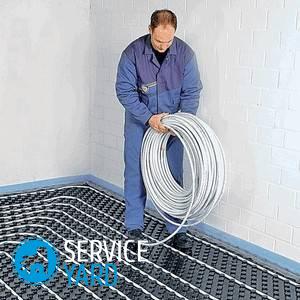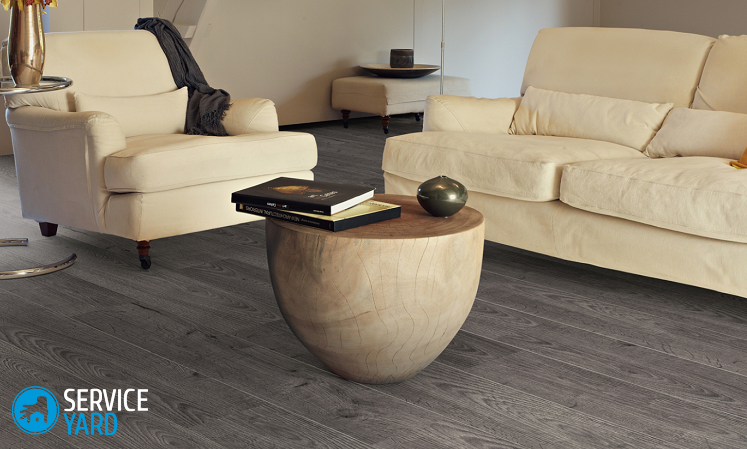Laying a laminate on a warm water floor

More recently, it was not possible to use a laminated board as a floor covering on the basis of a warm water floor. Laminate simply lost its qualities, deformed and cracked, since it was not designed for this kind of operation. However, the use of the laminate as a floor covering gained high popularity among the population, and manufacturers improved its technical characteristics. Now laying the laminate on a warm water floor has become quite real, moreover, such a combination is quite common. We will analyze some features of this process in this article.
to contents ↑How to choose a laminate for a warm water floor?
If you decide to use a warm water floor as heating in your home, and laminate as a floor covering, then it is worth considering some subtleties and nuances.
It is known that in the case of underfloor heating, the air in the room warms up more evenly than when heated with radiator batteries. However, for the correct functioning of the heating system, it is necessary that good thermal conductivity is observed. To fulfill this requirement, it is necessary to lay a high-quality screed, in accordance with all the norms of laying a warm water floor. High-quality screed will evenly heat up, transfer heat to the floor. Accordingly, there are certain requirements for choosing a laminate.
What should you look for when choosing a floor covering?
- The packaging must be marked with compatibility with underfloor heating. In the case of laying the laminate on the water floor, pay attention to the presence of a note that the manufacturer allows the use of this coating specifically with floors of this type of heating.
Important! Not always the laminate used under the electric floor is suitable for laying on water heating pipes.
- Pay attention to the permissible heating temperature. Often, a coating suitable for use in conjunction with such floors has a limitation of 27-28 degrees. This rule must be observed throughout the entire service life.
Important! It is unacceptable to use a laminate with lower rates, since such a coating will not withstand the constant exposure to the coolant, it will lose its characteristics.
- Give preference to thinner boards. The optimal thickness of the boards is 8-10 millimeters. Boards with a thickness of more than 10 millimeters will not warm up well, their use is inefficient.
- Laying a laminate on a warm floor is recommended if the total thermal resistance of the substrate and board does not exceed 0.15 square meters. m at K / W. If these requirements are met, then heating in this way will be cost-effective.
- Use a laminate of exceptionally high grades, as it is more resistant to temperature extremes.
- Get a substrate designed for laying on a warm floor. It must be porous and transmit heat well to the floor.
- Stop your choice on a coating with a castle type of joint - it is much better suited for laying on underfloor heating. A material with an adhesive joint is not suitable for these purposes, since heating can adversely affect the adhesive.
Important! The coating should have the highest possible moisture resistance.
- Laminated boards should contain a minimum of formaldehyde and harmful resins that may be released when heated.
- Choose a trusted and well-known manufacturer who has successfully established himself in the market. This will ensure that all markings are true.
Installation of underfloor heating
If the process of choosing a laminate is completed, it is worth familiarizing yourself with the features of its installation on the water floor. In general, the technology of laying it is no different from laying directly on the screed. However, there are certain subtleties that must be considered when carrying out work.
Heating system equipment and preparatory work for laying laminate
How to lay a laminate on a warm water floor? First you need to mount the heating system and prepare the surface for laying the laminate. The work is carried out in the following sequence:
- They are determined with the zone of laying heating pipes - they should not pass in places of future installation of heavy furniture. Heated areas must be open. If there are heating radiators in the room, do not lay underfloor heating in the immediate vicinity, otherwise overheating of this area is possible.
- If the room has an old floor, carry out its dismantling. The roughing screed should have a difference of not more than 3 mm. Keep in mind that taking into account the laying of heating pipes, screed and coating the surface with laminate, the total floor height will rise significantly.
- If there are bumps or a rough screed is needed, fill and level the floor. Experts recommend using expanded clay when pouring the surface. It perfectly retains heat.
- After drying, a waterproofing film and insulation are laid on the surface - it is best if it is foil foamed foam.
- Before laying pipes on the surface, a reinforcing mesh is laid.
- Then proceed directly to the laying of pipes for heating.
- After all the circuits are laid, connected, you are convinced of their correct operation, they glue the damper tape around the perimeter of the room - it will prevent the appearance of cracks in the finish filling the floor.
- At this stage, the floor is finished. For these purposes, use a cement mortar. The thickness of the layer is usually about 5-7 centimeters.
- When the screed is dry, the entire surface is primed. The primer fastens all small particles of dust, the surface itself, which extends the life of the floor covering.
- After complete drying, the surface is ready for laying the laminate ..
Laminate flooring
As you can see, the installation of a warm water floor requires certain skills and knowledge in the field of plumbing. Often the hosts invite specialists in this field. After the heating pipes are securely and qualitatively hidden in the screed, you can proceed to the next important step - laying the laminate on a warm water floor. This procedure is not so complicated, unlike the installation of the heating system, it can easily be handled independently
To do this, you must adhere to the following recommendations and sequence:
- First of all, it is necessary to create the desired climate in the room, turn on the heating system and warm up at maximum for 3 days. Turn off the heating and let the correct microclimate settle down for several days.
- The next step is the laminate should adapt to the climate of the room. It must be brought into the house 3 days prior to installation, unpacked and allowed to adapt.
- In the meantime, you can lay the substrate under the laminate.
- After the required time, the laminate is laid on the substrate. Moving from the wall, they begin to connect it with the help of lock joints, if necessary, cut the desired length of the strips.
Important! All work on sawing planks must be carried out in a separate room, dust is not allowed under the floor covering.
- Please note that when laying the flooring, it is necessary to leave a gap against the wall. This will enable the laminate to move with expansion, because this is a natural and inevitable process. When laying the first row of cover, wedges of the right size are inserted between the plank and the wall, which correspond to the recommended clearance.
Important! Experts advise to leave a gap of 1-1.5 centimeters in size, depending on the thickness of the future baseboard. The skirting board should subsequently cover the gap.
- After laying the coating on the entire surface of the floor, you can begin installing skirting boards.
At this stage, the installation process of the warm floor can be considered completed. If the work is done efficiently and in accordance with all the recommendations, the heating system should work properly. The point is small - it is enough to competently operate the laminate and heating system, taking into account the coating used on it.
to contents ↑Features of the operation of the laminate and floor heating
Experts say that choosing the right laminate flooring is just half the story of a successful laminate neighborhood with a warm water floor. To prevent the floor covering from being exposed to aggressive thermal influences and not being deformed, it is necessary to follow the recommendations for the operation of a laminate laid on a warm water floor.
The following guidelines for operating the system and flooring should be followed:
- The flooring does not like sudden temperature changes, so do not sharply turn on the system after long breaks, during periods of severe frost.
- Temperature fluctuations within 3-5 degrees are permissible per day. If the room stood idle without heating for a long time and it became necessary to warm it up, then it is necessary to raise the temperature gradually, raising it by 3 degrees per day.
- In the first days after laying the laminate, do not raise the floor temperature above 20 degrees.
- Do not set the floor temperature above the allowable laminate heating temperature. As a rule, it is 27-28 degrees. A floor temperature of 25-26 degrees is enough to maintain a comfortable microclimate in the room. Comfortable is the temperature in the room within 18-23 degrees.
- Install a thermometer and a hygrometer in the room - it will become much easier to control the microclimate.
- Keep track of the humidity level in the room - it should be stable within 40-60%. Too low humidity contributes to the drying of the flooring, high humidity leads to its swelling and expansion. To maintain a constant figure of the level of humidity, use a humidifier if the humidity needs to be increased regularly, or use an air conditioner to drain the air if humidity needs to be lowered.
Stock footage
As you can see, laying a laminate on a warm floor, not particularly difficult. The installation process is no different from ordinary laying on floors without heating. The most important thing is to carefully carry out all the preparatory work, and then adhere to the recommendations on the operation of water heating systems.
- How to choose a vacuum cleaner taking into account the characteristics of the house and coatings?
- What to look for when choosing a water delivery
- How to quickly create comfort at home - tips for housewives
- How to choose the perfect TV - useful tips
- What to look for when choosing blinds
- What should be running shoes?
- What useful things can you buy in a hardware store
- Iphone 11 pro max review
- Than iPhone is better than Android smartphones




